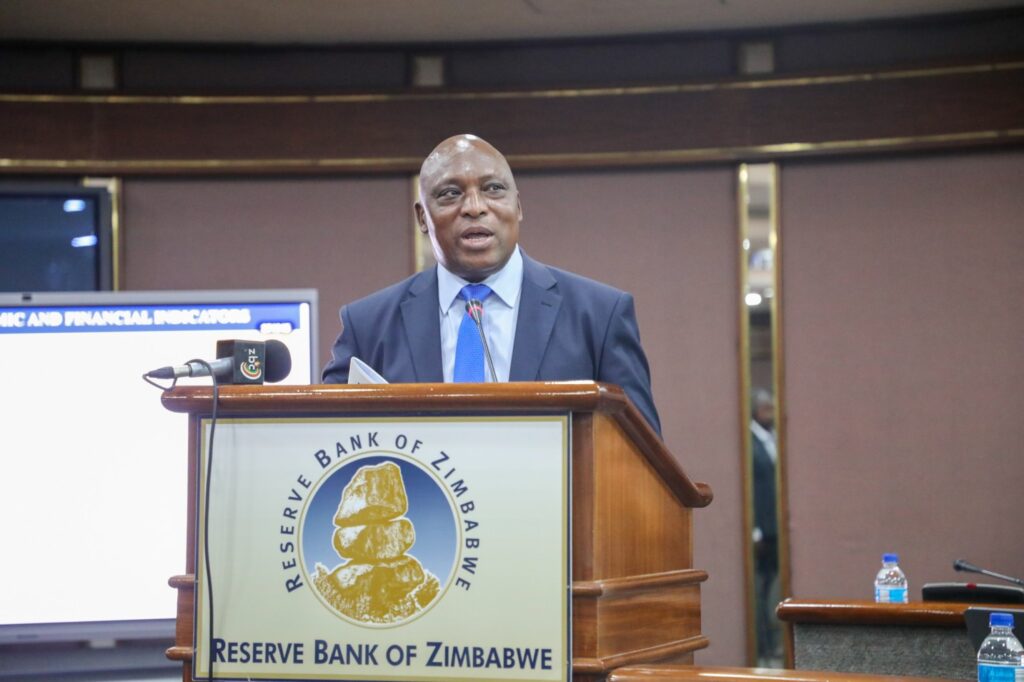Reserve Bank Governor reaffirms commitment to “walking the talk” as inflation remains subdued, foreign reserves surge over 150%, and ZiG currency gains broader acceptance across the economy
HARARE, Zimbabwe – The Reserve Bank of Zimbabwe (RBZ) announced it will maintain its tight monetary policy stance and keep the bank policy rate at 35% in its comprehensive 2025 Mid-Term Monetary Policy Statement released on August 7, as the southern African nation continues to experience unprecedented macroeconomic stability following the introduction of the Zimbabwe Gold (ZiG) currency in April 2024.
Governor Dr. J. Mushayavanhu, delivering the statement themed “To durably anchor and consolidate stability,” emphasized the central bank’s unwavering commitment to “walking the talk and staying the course” in implementing policies that have successfully anchored price, currency, and exchange rate stability over the past 15 months.
Stay informed and empowered with practical business ideas for Zimbabwe — follow ZimLedger on our WhatsApp Channel: https://whatsapp.com/channel/0029VbBKdAn30LKXCPTKdM1Z
Remarkable Inflation Performance Defies Regional Trends
The most striking achievement highlighted in the 46-page policy document has been Zimbabwe’s dramatic inflation performance. Monthly ZiG inflation has remained remarkably low and stable, averaging just 0.64% from February to July 2025, with monthly rates ranging between -0.1% and 0.9% during the first half of the year.
This represents a stark contrast to Zimbabwe’s hyperinflationary past and stands out regionally, where many African economies continue to grapple with elevated price pressures. The stability has been underpinned by the relative stability of the ZiG/US$ exchange rate and prudent monetary policy management.
While annual inflation stood at 95.8% in July 2025, Governor Mushayavanhu explained this largely reflects base effects from a one-off spike in month-on-month inflation in October 2024. “The current trend in annual inflation is expected to dissipate from October 2025 and align with the current low and stable monthly inflation,” the statement noted, projecting annual inflation to moderate significantly to around 30% by year-end.
The central bank’s inflation targeting approach focuses on controlling reserve money as the operational target to stabilize the ZiG/US$ exchange rate, which serves as the intermediate target for achieving the ultimate objective of price stability.
Foreign Reserves Experience Unprecedented Growth
Perhaps the most significant macroeconomic achievement has been the dramatic improvement in foreign currency reserves, which have grown from a precarious US$285 million in April 2024 to over US$730 million by June 2025 – representing an increase of more than 150% in just over a year.
This reserve accumulation has been facilitated by substantially increased foreign currency inflows. Total foreign currency receipts for the period January to June 2025 amounted to US$7.3 billion, compared to US$5.9 billion received during the same period in 2024, representing a robust 23.1% increase.
The improved inflows have been driven primarily by:
- Strong export performance, particularly in mining and agriculture
- Increased international remittances
- Growing investor confidence in Zimbabwe’s macroeconomic stability
- Enhanced foreign exchange market efficiency
The Reserve Bank noted that foreign currency payments during the same period totaled US$5.0 billion, up 17% from US$4.3 billion in the previous year, indicating healthy import activity supporting economic growth while maintaining a positive balance of payments position.
Governor Mushayavanhu indicated the central bank will continue accumulating reserves toward the regional benchmark of 3-6 months of import cover to provide adequate buffer against external shocks and support sustained currency stability.
ZiG Currency Gains Traction Across Economy
The Zimbabwe Gold currency, backed by gold and foreign currency reserves, has demonstrated remarkable resilience and growing acceptance since its introduction. Electronic ZiG transactions in the National Payment Systems have risen dramatically from 26% in April 2024 to over 40% in June 2025, reflecting increased confidence and usage of the local currency.
The ZiG/US$ exchange rate has remained largely stable, closing June at ZiG26.95 per US$, with the exchange rate premium contained below 30% since January 2025. This stability has been crucial in maintaining price stability and supporting business confidence.
To enhance ZiG circulation and availability, the Reserve Bank has implemented several measures:
- Banking institutions required to maintain at least 3% of ZiG deposits as cash for distribution
- Enhanced ZiG cash distribution through ATMs and banking halls
- Banks currently holding over ZiG200 million in vaults awaiting distribution
- Modernization of ZiG banknotes progressing at an advanced stage
The improved macroeconomic environment has also supported fiscal policy coordination, with the implementation of a 50:50 basis for local and foreign currency settlement of Quarterly Payment Dates (QPDs) significantly increasing demand for ZiG.
Economic Growth Projected to Accelerate Significantly
Despite challenging global economic conditions, Zimbabwe’s economy is projected to achieve robust growth of 6% in 2025, representing a dramatic improvement from an estimated 1.7% in 2024. This growth projection reflects broad-based recovery across multiple sectors of the economy.
Agricultural Sector Revival
The agricultural sector has experienced a remarkable turnaround in 2025, with improved production across all major crops. Most notably:
- Tobacco output has surpassed historical records, with deliveries exceeding 351 million kg as of July 31, 2025
- Improved rainfall patterns and farmer support programs have boosted crop yields
- Enhanced access to foreign currency for agricultural inputs has supported productivity
Mining Sector Expansion
The mining sector has maintained its bullish performance, driven particularly by gold production:
- Gold deliveries rose to 20.1 tonnes by end-June 2025, compared to 13.85 tonnes during the same period in 2024
- Increased gold production has directly supported ZiG backing and foreign currency reserves
- Other mineral exports have also contributed to improved foreign currency earnings
Manufacturing and Services Recovery
The manufacturing sector has benefited from improved access to foreign currency through the Willing-Buyer Willing-Seller (WBWS) foreign exchange market, while the tourism sector has shown signs of recovery as regional and international confidence in Zimbabwe’s stability improves.
Banking Sector Demonstrates Continued Soundness
The financial sector continues to demonstrate remarkable stability and soundness despite global banking sector challenges. As of June 30, 2025, 17 out of 19 banking institutions reported core capital above minimum regulatory capital requirements.
Key banking sector indicators include:
- Non-performing loans ratio improved to 2.89% as of June 2025, down from 3.37% in December 2024
- Adequate capitalization across most institutions
- Stable funding profiles supported by growing deposit bases
- Enhanced operational efficiency through digital transformation initiatives
The National Payment Systems have demonstrated stability and safety throughout the first half of 2025, with steady transaction growth indicating a healthy financial environment. Significant advances in instant payment schemes and mobile money services have enhanced financial inclusion and transaction efficiency.
Comprehensive Stakeholder Engagement Shapes Policy
The monetary policy statement followed extensive consultations with key stakeholders conducted from July 7-14, 2025, representing a broad cross-section of Zimbabwe’s economy. Participating organizations included:
- Zimbabwe National Chamber of Commerce (ZNCC)
- Commercial Farmers Union and Zimbabwe Farmers Union
- CEO Africa Roundtable
- Zimbabwe Council of Churches
- Bankers Association of Zimbabwe (BAZ)
- Confederation of Zimbabwe Industries (CZI)
- Chamber of Mines
- Consumer Council of Zimbabwe
- Various business associations and economic commentators
Stakeholders generally commended the prevailing macroeconomic stability while providing input on specific policy areas. Key themes from consultations included:
Policy Consistency Appreciation
Stakeholders welcomed the Reserve Bank’s consistent implementation of monetary policy measures, describing the approach as “walking the talk” in delivering on policy commitments.
Interest Rate Concerns
Some stakeholders proposed a downward review of the 35% bank policy rate, arguing it may be constraining credit access. However, the Reserve Bank maintained that the current rate is well-calibrated, projecting it will deliver a positive real interest rate of 5% based on expected year-end inflation of 30%.
De-dollarization Roadmap Clarity
Stakeholders emphasized the need for a clear de-dollarization roadmap, particularly regarding the fate of US dollar deposits and contracts beyond 2030. The Reserve Bank indicated this roadmap will be crystalized in the forthcoming National Development Strategy II (NDS2).
Key Policy Measures Maintained and Enhanced
Interest Rates and Banking Charges
- Bank Policy Rate maintained at 35%, subject to continuous review by the Monetary Policy Committee
- Minimum deposit interest rates maintained: ZiG deposits (5% savings, 7.5% time deposits), USD deposits (2.5% savings, 4% time deposits)
- Continued exemption from bank charges for accounts below US$100 equivalent
- Point-of-sale transactions under US$5 equivalent remain exempt from charges
Reserve Requirements and Liquidity Management
- Statutory reserve requirements maintained between 15-30% depending on deposit type
- Differentiated structure encourages long-term deposits and supports financial stability
- Non-Negotiable Certificates of Deposit (NNCDs) recalibrated in May 2025 to 30-day fixed terms with zero coupon
Foreign Exchange Market Operations
- Export surrender requirement maintained at 30% (retention rate 70%)
- Willing-Buyer Willing-Seller market continues to provide adequate foreign currency access
- Enhanced monitoring of foreign exchange trading margins
- Targeted Finance Facility continues supporting productive sectors
Enhanced Compliance and Regulatory Measures
The Reserve Bank announced significantly increased penalties for non-compliance with exchange control regulations, raising fines to 1% of transaction amounts or US$100,000 (whichever is greater), or suspension/revocation of trading licenses.
Common violations being addressed include:
- Non-acquittal of export/import documentation
- Falsification of trade documents
- Non-registration of external loans
- Under-declaration of exports and over-pricing of imports
- Abuse of the interbank foreign exchange market
Global Economic Context and Risk Management
The policy statement acknowledged challenging global economic conditions, with the IMF projecting global growth to moderate from 3.3% in 2024 to 3.0% in 2025. Key global risks include:
- Escalating trade tensions and tariff impacts
- Tighter financial conditions
- Slower pace of global disinflation
- Supply chain disruptions
Governor Mushayavanhu emphasized the Reserve Bank’s vigilance in ensuring appropriate policy measures to strengthen domestic economic resilience against external shocks.
Forward-Looking Policy Initiatives
Sustainability and Climate Risk
The Reserve Bank announced plans to conduct surveys assessing banking sector preparedness for International Sustainability Standards Board (ISSB) disclosure requirements, aligning with Government’s early adoption of sustainability standards.
Financial Inclusion and Gender Diversity
New requirements include:
- Banking institutions must submit gender equality and disability inclusion roadmaps by December 31, 2025
- Enhanced financial literacy outreach programs, particularly for rural and marginalized communities
- Quarterly reporting on financial literacy initiatives
Currency Discrimination Monitoring
The Financial Intelligence Unit will monitor compliance with fair trading practices, ensuring goods and services are equally available in both ZiG and USD, with particular focus on mobile network operators and airtime purchases.
Economic and Inflation Outlook
Looking ahead, the Reserve Bank projects continued macroeconomic stability supported by:
- Monthly inflation remaining between 1-3%
- Annual inflation declining to below 30% by year-end
- Current account surplus improving to US$621.7 million in 2025
- Sustained foreign currency inflows supporting reserve accumulation
- Continued ZiG adoption and usage expansion
The central bank emphasized its commitment to maintaining the delicate balance between inflation control and supporting robust economic growth, with the Monetary Policy Committee continuing to monitor economic fundamentals and adjust policies as necessary.
Key Takeaways and Market Implications
Governor Mushayavanhu concluded the statement with four key takeaways emphasizing the Reserve Bank’s continued commitment to:
- Walking the talk and staying the course in implementing stability-focused policies
- Consolidating ZiG gains while addressing potential outlook risks
- Encouraging business model recalibration to accommodate increased ZiG usage
- Maintaining balance between inflation reduction and robust economic growth
The comprehensive policy framework represents a continuation of Zimbabwe’s monetary policy success story since the introduction of ZiG, with stakeholders and markets responding positively to the consistency and credibility demonstrated by the central bank.
The next monetary policy review is expected in early 2026, with the Monetary Policy Committee maintaining its data-dependent approach to policy adjustments based on evolving economic conditions and fundamentals.
ZimLedger
ZimLedger is the all in one business and finance platform for Zimbabwe. It generates quotes, invoices, payslips and financial statements, manages business ledgers, tracks income and expenses, and builds shopping lists. ZimLedger offers a simple yet powerful solution tailored to local needs. Whether you are budgeting in ZiG or USD, managing business accounts, converting Ecocash statements, or tracking household expenses, ZimLedger empowers you to stay organised, make informed financial decisions, and grow your wealth—right from your phone or computer.













